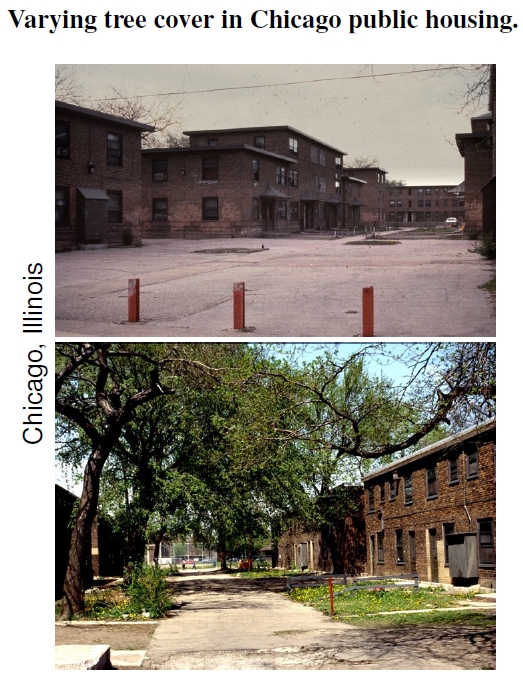5. 8 Trees & Public Housing
 Figure 5.8: Views of the Ida B. Wells Buildings in Chicago, Illinois (images by W.C. Sullivan, courtesy of F. Kuo; after Kuo and Sullivan 2001a). Top image shows a relatively tree-free view; bottom image shows a more “natural” view.
Figure 5.8: Views of the Ida B. Wells Buildings in Chicago, Illinois (images by W.C. Sullivan, courtesy of F. Kuo; after Kuo and Sullivan 2001a). Top image shows a relatively tree-free view; bottom image shows a more “natural” view.
Over the next few pages I discuss studies performed at two public housing complexes in Chicago, Illinois. One of these, the Ida B. Wells development (see Figure 5.8), was built in 1941 specifically for African Americans.[35] The United States has had a long history of “poorhouses,” resulting from a local responsibility of caring for the poor and elderly. During the late 1990s, the time of the study at this complex, the development housed nearly 6,000 people in 124 one- to four-story buildings. Researchers included 98 of the 124 buildings, leaving out buildings that, for one reason or another, were special cases.
According to housing development rules, staff assigned new residents to randomly chosen units. Random assignment means that people couldn’t pick and choose buildings with more or less vegetation, not to mention more or less crime. This placement meant a simplification for a statistical study because individual outlook and attitude, level of vegetation, and incidence of crime started out independently. As the two photos depict, tremendous variation existed in the vegetation surrounding these apartment buildings. Also keep in mind that social spaces surrounding these buildings developed haphazardly; enhancing social interactions wasn’t part of the environmental design of the buildings.
During the study, residents comprised 65% female, 97% African American, 93% unemployed, and 44% under the age of 14.[36] Serious social and economic strains make me think that vegetation was furthest from their many concerns. Still, using two years of crime reports from the Ida B. Wells homes, researchers correlated the type of crime with features of the location where the crime took place, including vegetation.
The Robert Taylor Homes was another public housing development in Chicago—the last remaining building was demolished in 2007 — and served as the site of two more studies involving people and vegetation, one exploring how vegetation calms people (Figure 5.9) and the other involving child development (Figure 5.10).
Again after special case exclusions, researchers examined 18 of the development’s 28 16-story buildings, surveying people in floors 2 through 4 where residents might view vegetation outside their apartment windows. The study included a total of 145 women under 65 years of age, correlating their reported levels of violence with the greenness of the view from their apartment.
I show results from both housing development studies on the next four pages.
————————————
[35]Kuo and Sullivan (2001a) report on the crime rate dependence on vegetation in the Ida B. Wells public housing development in Chicago, Illinois. Though the results are significant, vegetation explains only 7 to 8% of the variation in crime rates. Since the Kuo and Sullivan (2001a) study took place, the Chicago Housing Authority (CHA) combined the development with others, presently housing around a couple thousand people. Information on the current status of the Ida B. Wells public housing development can be found on the CHA’s website: www.thecha.org/housingdev/madden wells.html.
[36]On the one hand, apartment buildings and housing complexes provide a fantastic opportunity to learn how vegetation and its correlates affect people, but on the other hand, a vague, uneasy feeling comes over me about using these people’s difficult situation as the basis of a scientific study. I resolve this conflict in favor of learning about the people–vegetation link when I see the socioeconomic inequity in vegetation that I show in Figure 6.13. Furthermore, there’s quite a long history involving public housing in the United States, the responsibility of which once rested on families and communities to take care of their old, infirm, and poor. As communities grew into cities, public housing organization grew similarly. Clearly, studying people is the nature of the social sciences, and it’s a valid question to ask what consequences result when people have very little vegetation.